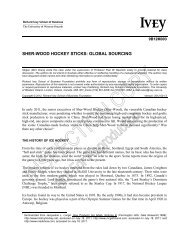foundation of canada asia pacific - Content Tagged with
foundation of canada asia pacific - Content Tagged with
foundation of canada asia pacific - Content Tagged with
You also want an ePaper? Increase the reach of your titles
YUMPU automatically turns print PDFs into web optimized ePapers that Google loves.
MAJOR EVENTS<br />
2<br />
a year in review<br />
21<br />
After two consecutive years <strong>of</strong> crisis and contraction, 1999 was the year <strong>of</strong> recovery for<br />
the countries <strong>of</strong> Asia that were caught in the currency collapse <strong>of</strong> 1997. Economy after<br />
economy began recovering, led by South Korea that recorded a dramatic turnaround from<br />
a contraction <strong>of</strong> 5.5% in its GDP in 1998 to growth <strong>of</strong> just under 10% last year. Thailand,<br />
the Philippines, Malaysia and Hong Kong SAR all resumed their expansion after losing<br />
ground the year before, while Indonesia, the hardest hit <strong>of</strong> all, saw the contraction <strong>of</strong> its<br />
economy almost come to an end as it struggled to bring equilibrium to its political as well<br />
as its economic system. Overall, it seems the Asian growth engine is powering up again.<br />
However, beneath the surface remain financial and structural problems that the rapid<br />
recovery is tending to cover up. The restructuring <strong>of</strong> debt-ridden corporations has really<br />
only just begun, while financial bail-outs have forced governments to take on unfamiliar<br />
debt burdens that will be a drain on national budgets. China and Japan were not contagion<br />
victims, but continue to wrestle <strong>with</strong> their own serious domestic problems <strong>of</strong> anemic<br />
consumer demand that raise as many questions about public morale as they do about their<br />
economies. The one unqualified bright spot was India, which missed out on the Asian<br />
crisis altogether. It turned in yet another year <strong>of</strong> strong growth, making it the best performer<br />
in Asia in the second half <strong>of</strong> the 1990s — if you take China’s GDP figures <strong>with</strong> a grain <strong>of</strong> salt.<br />
It was also a year in which the democratic process, if not achieving full political openness,<br />
recorded significant advances in the region. Overshadowing all else was Indonesia. It<br />
managed a surprisingly smooth transfer <strong>of</strong> power from the transitional presidency <strong>of</strong> B.J.<br />
Habibie (a long-time Suharto protégé) to popular Muslim cleric Abdurrahman Wahid.<br />
Despite having no tradition or recent experience <strong>of</strong> democracy, the complex congressional<br />
elections, then the controversial selection <strong>of</strong> a president, were carried out fairly, if somewhat<br />
boisterously. In hindsight, the process appears to have reflected the will <strong>of</strong> the people.<br />
Most aspects <strong>of</strong> it were open. Even the unsuccessful attempt by the outgoing Golkar<br />
government to siphon funds out <strong>of</strong> Bank Bali to buy the election became a matter <strong>of</strong><br />
public record. India, a country <strong>with</strong> an established democracy, proved again, <strong>with</strong> the<br />
re-election <strong>of</strong> a coalition government led by A.B. Vajpayee, that a competitive electoral<br />
system can function in a multi-ethnic nation <strong>of</strong> more than one billion people. And<br />
Malaysia demonstrated again that, despite the autocratic tendencies <strong>of</strong> outspoken Prime<br />
Minister Dr. Mahathir Mohamad, the country is a functioning democracy, even if the



